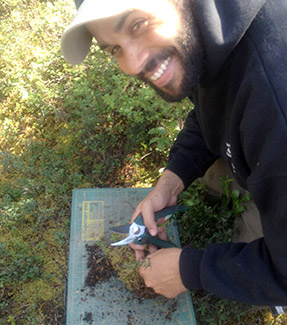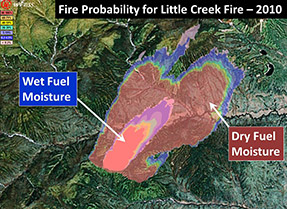Denali National Park, Alaska
Cohesive Strategy -- Response to Wildfire*
How Dry Is It?

NPS Photo / Jennifer Barnes
The amount of moisture in various types of vegetation can help fire managers determine if a fire is likely to start and how it might behave once ignited. Fuel moisture strongly influences fire ignition potential and flammability. The drier the fuels, the easier they are to burn.
Fuel moisture is an essential part of a system of indices that fire managers in Alaska (AK) rely on to estimate fire danger. The Canadian Forest Fire Danger Rating System (CFFDRS) represents moss and duff fuel moisture and is calculated from weather data. Fuel moisture is also an integral part of predicting fire behavior and fire spread probabilities.
An interagency effort is now underway to compare CFFDRS indices to actual duff moisture, provide near real time live fuel moistures for fire behavior modeling and track moisture levels throughout the season.
How Do We Know?
Beginning in 2012, fire ecologists from the National Park Service (NPS), Bureau of Land Management Alaska Fire Service and US Fish & Wildlife Service spearheaded a large effort to monitor live fuel moisture trends throughout AK. The AK NPS fire ecology program established sampling sites in Denali National Park and Preserve and in Fairbanks, AK.
For the past two seasons, fire staff has collected “live” fuels including stems and leaves or needles from shrubs and conifers along with herbaceous plants (grasses) to determine moisture content. “Duff plugs” were also collected which consists of live and dead fuels, brown moss on top and deeper layers of decomposing moss and organic material (duff). Feather mosses dry quickly and can easily carry a surface fire. The deeper duff layers generally indicate seasonal drying and drought conditions.
Why Does It Matter?

Information gained will improve fire danger rating indices and fire behavior modeling parameters needed for fire protection and preparedness planning. Live fuel moisture data is used in fire behavior programs to help determine how fast a fire may spread and whether a crown fire might occur. Duff fuel moisture data will be used to calibrate outputs of the CFFDRS fire danger indices in the spring.
All fuel moisture data is available to NPS fire managers and other interagency fire programs in AK at the National Fuel Moisture Database website. The AK NPS fire ecology program plans to continue these monitoring efforts in response to the needs of the fire management community.
Contact: Jennifer Barnes, Regional Fire Ecologist
Email: e-mail us
Phone: (907) 455-0652
Last updated: December 15, 2017
